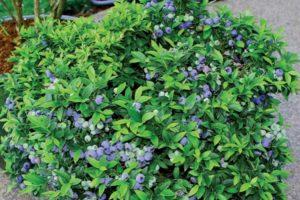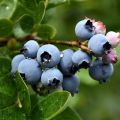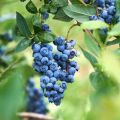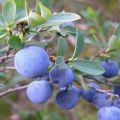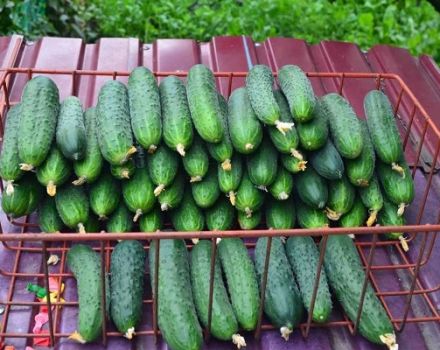Description and characteristics of Denis Blue blueberries, planting and care
Denis Blue was first developed in North America. Since the 20th century, the bush has been cultivated by summer residents. A variety of berry plants is unpretentious in care, it easily takes root in open areas. The variety is suitable for cultivation for personal consumption or on an industrial scale. In order to properly plant a bush, to care for it in accordance with the norms, you must familiarize yourself with the information below.
History of origin
Garden blueberries, native to America, were previously grown in the wild. Due to breeding activities, varieties were created that were distinguished by high yields, resistance to low temperatures. The blueberry bush is tall, capable of growing up to 3 meters high. The berries are tasty, sweet, without sourness. Varietal bushes have taken root in the gardens of Moscow, the Moscow region and the CIS countries since the late 1990s.
Advantages and disadvantages of Denis Blue blueberries
The blueberry bush variety suggests a number of positive and negative aspects that you need to familiarize yourself with.
| pros | Minuses |
| The berries are tasty, have a long shelf life | Lower yield compared to other blueberry varieties |
| Bushes can serve as a decorative element | Demanding soil acidity |
| Unpretentious care | |
| High resistance to frost |
Description and varietal characteristics
The blueberry variety belongs to the group of New Zealand varieties. Berries are widely appreciated in Europe, USA, Australia. The fruits are one of the largest among their fellows, the taste is unusually pleasant. The plant is stocky and tolerates various weather conditions. The bush reaches a height of 1.5 meters. The species ripens 2 weeks later than Bluecrop, but ripening is amicable.
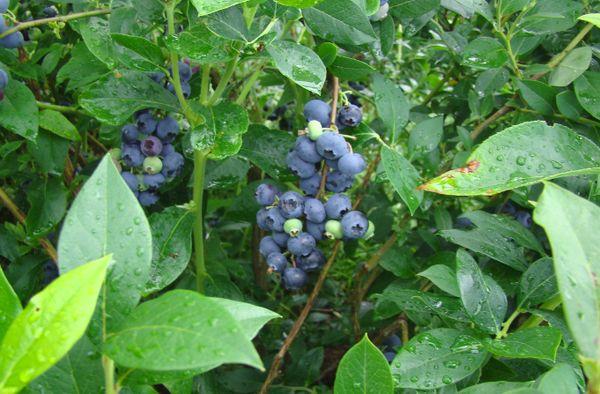
Harvested by mid-July or early August. Productivity is regularly high; adult shrubs yield up to 7 kg of blueberries. The culture bears fruit in the 3rd year after planting. In the first year of the bush's life, it is better to cut off all flowers so that it does not waste energy on pollen. The maximum results are observed in the 5th year after planting. The variety needs periodic pruning, the central part is thinned out.
Blueberry variety Denis Blue is famous for the following characteristics:
- leaves narrowed downwards, pointed, bright green color with glossy sheen;
- pinkish flowers;
- fruits are bright blue, saturated color, with a whitish bloom, weight reaches 1.8 grams, good transportability;
- multi-berry brushes, medium density, easy to harvest;
- good winter hardiness.
The last point is not suitable for northern latitudes. Blueberry bushes need to be insulated, since they will not withstand frosts below -35.
Planting technology
Blueberry Denis does not require special technologies when planting. The culture should be planted in places where there is no excess moisture, since this factor contributes to the death of the plant. The shrub prefers to grow in moderate humidity conditions. It is advisable to plant blueberries in open areas where there are no horticultural crops. The area where the berry will grow should be light and quiet, protected from drafts by other trees. It is advisable to give preference to a sunny place on the plot. These conditions will contribute to a good harvest.

Optimal timing
Denis Blue blueberries are planted preferably in March or October. The earth should warm up, the air temperature should be kept within at least 10 degrees Celsius. In the South, you can start planting in the fall, the seedlings will not freeze. In the northern and middle latitudes, postpone planting work until March, before sap flow.
Preparing the seedling and soil for planting
Planting material must be at least 2 years old. Prepare it in this way:
- for the rhizome to develop normally, dip it in a clay mash for 15 minutes;
- knead a dense lump of earth around the root system;
- straighten the rhizome, lay it horizontally for quick engraftment of the shrub.
On the prepared plot, from which the cut trees and weeds have been removed, it is necessary to dig holes for planting.
- Depending on what kind of land is on the site, they dig a hole 40 * 60 cm, or make a deepening of 10 cm inward in clay soil.
- The hole is filled to the top with the finished mixture, and a mound is made on clay soil.
- Mix and compact all components.
- When preparing holes, maintain a distance of 1 meter between the bushes.
Weed the soil so that it is saturated with oxygen. Do not plant blueberries in an area where there is accumulation of water. This is fraught with root necrosis. The soil should be light, sour, well-drained. The acidity reaction is normally pH 3.4-4.8.
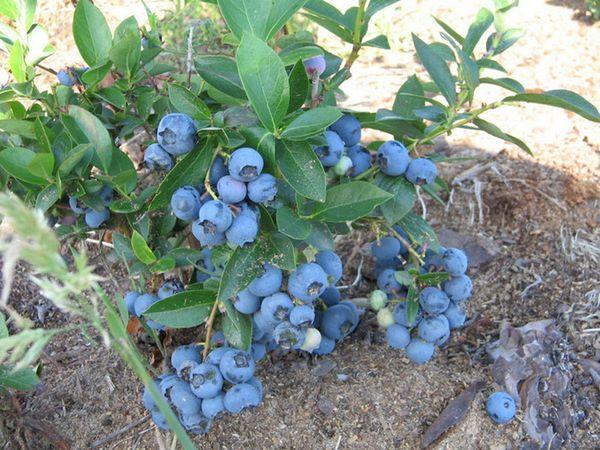
Planting process
Blueberries are planted according to the following steps:
- place the seedling in the hole, straighten the root system, cover it with earth;
- during planting, take into account that no feed is applied under the rhizome, the blueberries are squeezed later;
- watering the bush.
Mulching is carried out using sawdust, wood chips, which are poured in a layer of at least 10 cm thick.
Caring for tall blueberries
Caring for Denis Blue blueberries is easy, even an inexperienced gardener can cope with this task.
- Regular watering.
- Mulching.
- Fertilizer.
- Pruning.
- Maintaining the required level of soil acidity.
The last point involves watering the land under the bushes with diluted water with citric acid in a proportion of 1 tsp. for 3 liters, 9% vinegar 100 ml for 10 liters. They also use an electrolyte acidifier for batteries. Take 5 milliliters per 1 liter of water.

Irrigation frequency for bushes
Water the blueberries 2 times a week, 1 bucket per adult bush. It is important to do this in July-August, when the berries ripen, the next year's harvest is laid. In the heat, you can spray the plants with water from a spray bottle.
What and how to feed the variety
Fertilize blueberries with complex dressings 3 times during the growing season. The procedure is carried out in March, during pollen and until July 10. The volume of introduced substances should not exceed 1 tbsp. for a 2-year-old shrub for the entire season. For each year of life, plants double the amount of feed. You can use fertilizers for heather, universal combinations, Azofosku. Blueberries don't like manure.
If the culture does not "feel" well, this will be manifested by a change in the color of the leaves. The lack of mineral components, the acidity of the earth has changed - everything will be reflected in the leaves.
- When blueberries lack nitrogen, their leaves turn yellowish green, then reddish.
- Phosphorus deficiency is manifested by the purple tint of the leaves.
- Iron deficiency, or chlorosis - young lemon-colored leaves with a green mesh of veins.
- Lack of magnesium is caused by the red edges of old leaves.
- Sulfur deficiency is characterized by yellowish-white or white-pinkish foliage. The lack of this substance is fraught with a change in acidity, not feeding the culture.
It is necessary to closely monitor the lack of specific elements so that the plant gives a bountiful harvest and does not wither.

Formative Blueberry Pruning
Due to pruning, an increase in yield occurs, the fruits will be more tasty, large, presentable, the bush will be protected from diseases and beetles. The plant should be formed before sap flow.
The work is carried out in this way:
- young bushes form a bush from 2 years old, the branches are shortened by 1/3, all small branches are removed at the base, the buds are removed, which are going to bear fruit;
- adult bushes are pruned to increase fertility, removing the open branches, leaving only specimens growing upward.
Blueberries are famous for their good winter hardiness; they are sheltered only in the northern regions, where the temperature is low for a long time.
Prevention of disease and pests
Rarely, the bush is attacked by beetles, diseases. To prevent this from happening, preventive measures are taken. In March, before the start of sap flow, the bush is sprayed with Bordeaux liquid. After the foliage has bloomed, the manipulation is repeated with Topsin M 0.2%, Euparen, Roval. In November, as the leaves fall, carry out the fungicide treatment again.
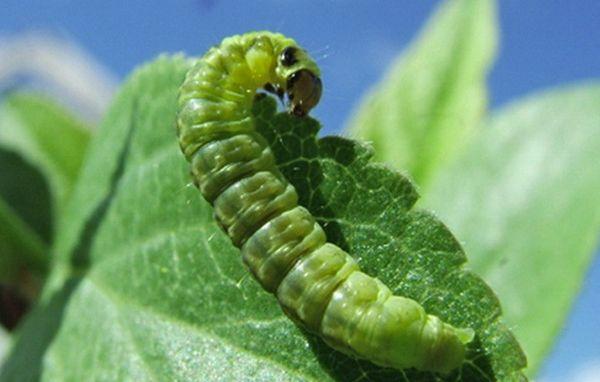
Frost protection
Blueberry Denis Blue will withstand a drop in temperature to -30, but if the cyclone is short, the bush is covered with snow. To protect the berries from freezing, drying, it is necessary to tie the culture with spruce branches. The needles will contribute to the retention of snow, protection from hares who wish to feast on branches. You can build a frame, pull the burlap on top. Usually unripe branches freeze, therefore, it is necessary to create conditions to ensure the completion of growth and maturation of the wood. After July 10, fertilization is stopped.
Blueberry reviews
The gardeners' responses to Denis Blue's blueberries are mostly positive.
Tamara Viktorovna, 43 years old, Kislovodsk:
Denis Blue's blueberry bush is easy to grow, bears juicy fruits, and survives winters well. The variety is worthy for breeding, from the berries I prepare my canning for the winter, the children also eat fresh berries.
Olga Petrovna 50 years old, Mr. Bragin:
This blueberry variety Denis Blue won me over with its size and, above all, the taste of the fruit. On the site we work mainly with my husband, compared to our other pets, blueberry bushes are easy to care for and do not require excessive attention. There is enough harvest and to eat fresh, and to preserve something, the husband even wants to try to make a liqueur from blueberries.

